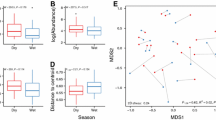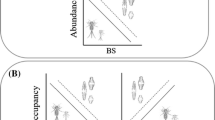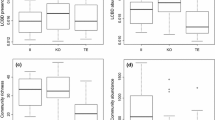Abstract
The interspecific relationship between local abundance and regional distribution, as well as the occupancy frequency distribution, are widely studied topics in macroecology. A positive abundance–occupancy relationship has been found in a majority of studies, and satellite species modes are typically dominant in occupancy frequency distributions. However, there are a number of exceptions to these “general” findings, and only a few studies have examined these patterns and their temporal variability in stream organisms. I examined both abundance–occupancy relationships and occupancy frequency distributions in stream insects in a boreal drainage system over six consecutive years. I found that the positive interspecific abundance–occupancy relationship was highly stable temporally, with coefficients of determination ranging from 0.25 to 0.47 over the years. There were no strong differences in the strength and slope of the abundance–occupancy relationship between non-predatory and predatory insect species in each year. Temporally stable abundance–occupancy relationships were paralleled by among-year patterns in both abundance and occupancy, with locally abundant and widely distributed species remaining locally abundant and widely distributed over the years, while locally uncommon and regionally rare species showed the opposite. Occupancy frequency distributions were strongly right-skewed, mirroring the dominance of the left-most satellite mode of regionally rare species. That the abundance–occupancy relationship, species’ abundances and distributions, as well as the dominance of satellite species in occupancy frequency distribution were temporally stable suggest that niche-based models are strong candidates for explaining these patterns in stream insects. By contrast, metapopulation-based models that predict clear temporal variability in species’ abundance and occupancy, as well as bimodal occupancy frequency distributions, are less plausible candidates for explaining the observed patterns. The present findings are the opposite to those in some terrestrial studies, but they are in agreement with other terrestrial studies and with a few previous studies on stream organisms.


Similar content being viewed by others
References
Allan JD (1995) Stream ecology. The structure and function of running waters. Chapman & Hall, London
Blackburn TM, Gaston KJ, Quinn RM, Arnold H, Gregory RD (1997) Of mice and wrens: the relation between abundance and geographic range size in British mammals and birds. Philos Trans R Soc Lond B 352:419–427
Blackburn TM, Gaston KJ, Greenwood JJD, Gregory RD (1998) The anatomy of the interspecific abundance-range size relationship for the British avifauna: II. Temporal dynamics. Ecol Lett 1:47–55
Blackburn TM, Cassey P, Gaston KJ (2006) Variations on a theme: sources of heterogeneity in the form of the interspecific relationship between abundance and distribution. J Anim Ecol 75:1426–1439
Bossuyt B, Honnay O, Hermy M (2004) Scale-dependent frequency distributions of plant species in dune slacks: dispersal and niche limitation. J Veg Sci 15:323–330
Brown JH (1984) On the relationship between abundance and distribution of species. Am Nat 124:255–279
Brown JH (1995) Macroecology. University of Chicago Press, Chicago
Collins SL, Glenn SM (1997) Effects of organismal and distance scaling on analysis of species distribution and abundance. Ecol Appl 7:543–551
Cowley MJR, Thomas CD, Wilson RJ, León-Cortés JL, Gutiérrez D, Bulman CR (2001) Density-distribution relationships in British butterflies: II. An assessment of mechanisms. J Anim Ecol 70:426–441
Gaston KJ, Blackburn TM (2000) Pattern and process in macroecology. Blackwell, Oxford
Gaston KJ, Kunin WE (1997) Rare-common differences: an overview. In: Kunin WE, Gaston KJ (eds) The biology of rarity: causes and consequences of rare and common difference. Chapman & Hall, London, pp 12–29
Gaston KJ, Lawton JH (1990) Effects of scale and habitat on the relationship between regional distribution and local abundance. Oikos 58:329–355
Gaston KJ, Blackburn TM, Lawton JH (1997) Interspecific abundance-range size relationships: an appraisal of mechanisms. J Anim Ecol 66:579–601
Gaston KJ, Blackburn TM, Greenwood JJD, Gregory RD, Quinn RM, Lawton JH (2000) Abundance-occupancy relationships. J Appl Ecol 37:39–59
Gotelli NJ (1991) Metapopulation models: the rescue effect, the propagule rain and the core-satellite hypothesis. Am Nat 138:768–776
Gotelli NJ, Simberloff D (1987) The distribution and abundance of tallgrass prairie plants: a test of the core-satellite hypothesis. Am Nat 130:18–35
Guo Q, Brown JH, Valone TJ (2000) Abundance and distribution of desert annuals: are spatial and temporal patterns related? J Ecol 88:551–560
Hanski I (1982) Dynamics of regional distribution: the core and satellite species hypothesis. Oikos 38:210–221
Hanski I (1994) A practical model of metapopulation dynamics. J Anim Ecol 63:151–162
Hanski I, Kouki J, Halkka A (1993) Three explanations of the positive relationship between distribution and abundance of species. In: Ricklefs RE, Schluter D (eds) Species diversity in ecological communities: historical and geographical perspectives. University of Chicago Press, Chicago, pp 108–116
Harvey PH (1996) Phylogenies for ecologists. J Anim Ecol 65:255–263
Heatherly T, Whiles MR, Gibson DJ, Collins SL, Huryn AD, Jackson JK, Palmer MA (2007) Stream insect occupancy frequency patterns and metapopulation structure. Oecologia 151:313–321
Heino J (2005a) Positive relationship between regional distribution and local abundance in stream insects: a consequence of niche breadth or habitat niche position? Ecography 28:345–354
Heino J (2005b) Metacommunity patterns of highly diverse stream midges: gradients, checkerboards and nestedness, or is there only randomness? Ecol Entomol 30:590–599
Heino J (2008) Influence of taxonomic resolution and data transformation on biotic matrix concordance and assemblage-environment relationships in stream macroinvertebrates. Boreal Environ Res (in press)
Heino J, Soininen J (2006) Regional occupancy in unicellular eukaryotes: a reflection of niche breadth, habitat availability or size-related dispersal capacity? Freshw Biol 51:672–685
Hengeveld R, Haeck J (1982) The distribution of abundance. I. Measurements. J Biogeogr 9:303–316
Hoffsten P-O (2004) Site-occupancy in relation to flight morphology in caddisflies. Freshw Biol 49:810–817
Holt AR, Gaston KJ (2003) Interspecific abundance-occupancy relationships pf British mammals and birds: is it possible to explain the residual variation. Glob Ecol Biogeogr 12:37–46
Holt RD, Gaston KJ, Lawton JH (1997) On the relationship between range size and local abundance: back to basics. Oikos 78:183–190
Malmqvist B (2000) How does wing length relate to distribution patterns of stoneflies (Plecoptera) and mayflies (Ephemeroptera)? Biol Conserv 93:271–276
Malmqvist B (2002) Aquatic invertebrates in riverine landscapes. Freshw Biol 47:679–694
Malmqvist B, Zhang Y, Adler PH (1999) Diversity, distribution and larval habitats of North Swedish blackflies (Diptera: Simuliidae). Freshw Biol 42:301–314
Maurer BA (1999) Untangling ecological complexity. The macroscopic perspective. University of Chicago Press, Chicago
McGeoch MA, Gaston KJ (2002) Occupancy frequency distributions: patterns, artefacts, and mechanisms. Biol Rev 77:311–331
Mykrä H, Ruokonen T, Muotka T (2006) The effect of sample duration on the efficiency of kick-sampling in two streams with contrasting substratum heterogeneity. Verh Int Ver Theor Angew Limnol 29:1351–1355
Moog O (ed) (2002) Fauna Aquatica Austriaca. Katalog zur autoökologischen Einstufung aquatischer Organismen Österreichs. Bundesministerium für Land- und Forstwirtschaft, Umwelt und Wasserwirtschaft, Wien
Nee S, Gregory RD, May RM (1991) Core and satellite species: theory and artefacts. Oikos 62:83–87
Palmer MA, Allan JD, Butman CA (1996) Dispersal as a regional process affecting marine and stream benthic invertebrates. Trends Ecol Evol 11:322–326
SPSS (2002) SPSS version 11.5 for Windows. SPSS, Chicago
Tales E, Keith P, Oberdorff T (2004) Density-range size relationship in French riverine fishes. Oecologia 138:360–370
Taylor CM, Warren ML (2001) Dynamics of species composition of stream fish assemblages: environmental variability and nested subsets. Ecology 82:2320–2330
Tokeshi M (1992) Dynamics of distribution in animal communities: theory and analysis. Res Popul Ecol 34:249–273
Wright DH (1991) Correlations between incidence and abundance are expected by chance. J Biogeogr 18:463–466
Acknowledgements
I thank S. Koljonen, T. Muotka, H. Mykrä, and A. Astorga for their help in the field, and Oulanka Research Station for logistical support. B. Bossuyt and R. Virtanen provided the Excel formulas for testing the occupancy frequency distributions. I also thank T.O. Crist and an anonymous reviewer for helpful comments on this paper and excellent ideas for further studies. Financial support was provided by the Academy of Finland (grants to J. Heino and T. Muotka) and Nessling foundation (grants to J. Heino and T. Muotka).
Author information
Authors and Affiliations
Corresponding author
Additional information
Communicated by Volkmar Wolters.
Rights and permissions
About this article
Cite this article
Heino, J. Temporally stable abundance–occupancy relationships and occupancy frequency patterns in stream insects. Oecologia 157, 337–347 (2008). https://doi.org/10.1007/s00442-008-1078-y
Received:
Revised:
Accepted:
Published:
Issue Date:
DOI: https://doi.org/10.1007/s00442-008-1078-y




